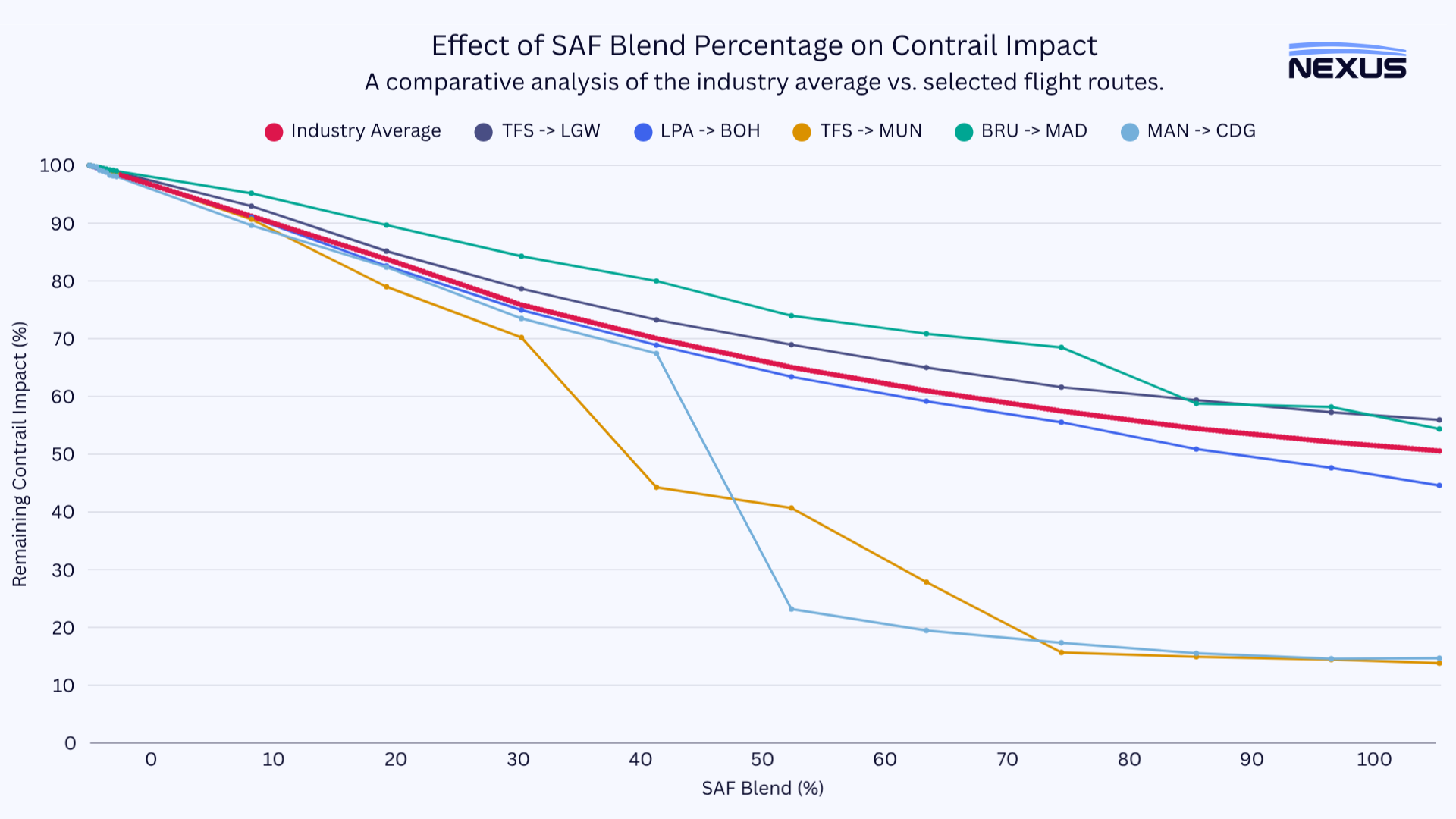How SAF Addresses Aviation's Non-CO₂ Climate Effects, Such As Contrails
Omar Nuruzade
Co-Founder & CEO
-
Nexus Lab
For years, the aviation industry's sustainability journey has been measured by a single metric: CO₂. While reducing carbon emissions remains a critical pillar of the industry's mission, a more comprehensive understanding of aviation's climate impact is coming into focus. The next frontier in sustainable aviation lies in addressing the significant, yet often overlooked, non-CO₂ effects, chief among them being contrail formation.
This marks a pivotal shift for sustainability managers, fuel efficiency, flight operations teams, and compliance teams. The conversation is no longer just about the carbon footprint of a flight but its total warming impact. Contrails, the white streaks planes leave behind in the sky, are now understood to have a warming effect potentially equal to 35% of the total accumulated climate impact from aviation. Addressing them is essential for any strategy aiming for climate-neutral flying.
The Dual Power of Sustainable Aviation Fuel (SAF)
This is where the role of Sustainable Aviation Fuel (SAF) becomes even more critical. While widely celebrated for its ability to slash life-cycle carbon emissions, SAF holds a second, equally powerful benefit: its potential to reduce the formation of contrails.
The science is compelling. Contrails form when soot particles from engine exhaust act as nuclei for ice crystal formation. Because SAF is a purer fuel with fewer aromatic compounds than conventional jet fuel, it produces significantly less soot. Fewer soot particles mean fewer seeds for contrails to grow from, leading to thinner, shorter-lived contrails or preventing their formation altogether.
Recent industry research, such as the landmark Airbus–DLR ECLIF3 study, provides powerful, real-world data confirming this dual benefit. The study estimated that using 100% SAF reduced the climate-warming impact of contrails by at least 26 percent compared to conventional jet fuel. This demonstrates that SAF is a critical tool available now for tackling both the CO₂ and non-CO₂ impacts of aviation.
However, the relationship between SAF blends and contrail reduction is not always linear. In a recent analysis of various real-world flights, Nexus Lab applied well-established contrail evaluation models to assess the impact of SAF blend percentages, demonstrating that the effect can vary significantly depending on the specific conditions of each flight. For some routes, a higher SAF blend triggers a sharp, dramatic decrease in contrail impact. For others, the reduction is more gradual and less pronounced. This variability underscores that the benefits of SAF are deeply intertwined with the operational context, such as the specific aircraft/engine, route, and prevailing weather conditions, all of which play a crucial role. It’s this complexity that makes robust, flight-by-flight analysis essential to truly quantify and maximize the non-CO₂ benefits of SAF adoption.
From Theory to Operations: What This Means for Airlines
Understanding this dual benefit is the first step; integrating it into daily operations is the next. This requires a new way of thinking for several key departments:
For Sustainability Managers: The business case for SAF just became much stronger. Strategy can now be framed not just around carbon offsetting, but around direct climate impact mitigation. This adds a powerful new dimension to ESG reporting and corporate climate goals.
For Fuel and Flight Operations Teams: The fuel procured and the routes planned have a direct effect on contrail formation. This opens the door for innovative operational strategies, such as prioritizing SAF on routes prone to contrail formation or utilizing weather forecasting tools to adjust flight paths to avoid ice-supersaturated regions in the atmosphere.
The need for these kinds of operational shifts is becoming urgent. From January 1, 2025, EU regulations require airlines to monitor and report their non-CO₂ effects under the EU ETS, with the first verified reports due in 2026. This data will be managed through the new NEATS (Non-CO2 Aviation Effects Tracking System) platform.
Accurate Monitoring, Reporting, and Verification (MRV) is no longer optional. A credible MRV system is the core engine for turning climate ambition into measurable, auditable action. This is precisely the challenge Nexus Lab addresses. Our platform provides a comprehensive system for contrail MRV by integrating key datasets and delivering compliance-ready outputs.
By integrating vast datasets, from flight operations and fuel usage to atmospheric weather data, our platform provides airlines with a comprehensive system for contrail MRV. This enables operators to not only comply with evolving regulations but also to proactively develop and validate mitigation strategies, including aircraft- and engine-specific contrail prediction and satellite validation, turning climate ambition into measurable action.




